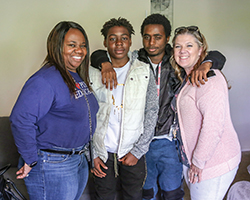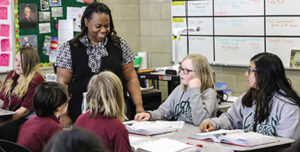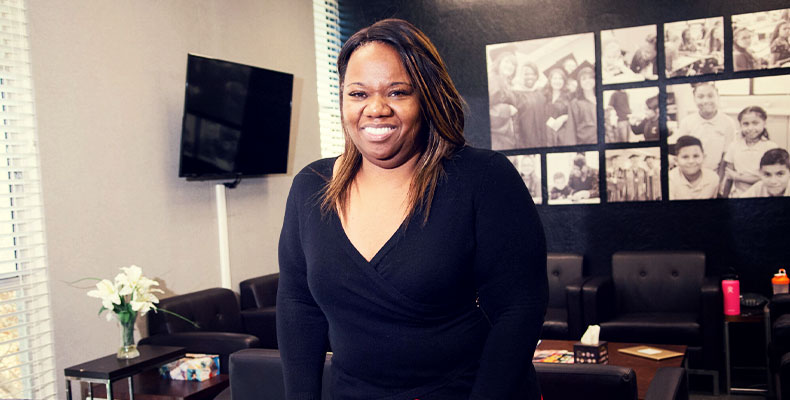Traci Davis: If You Haven't Made a Deposit, You Cannot Make a Withdrawal
As a classroom teacher and a specialist in the late 90s and early 2000s, I did home visits (a different model). One of my principals moved me out of the classroom to do home visits for the schools. My counterpart was a white female, and we worked at a school that was predominantly minority. That was an interesting time to learn how people viewed home visits and what school staff thought of parents. I learned a lot from that experience that I took with me as I became a principal.

Traci Davis (left), former superintendent of Washoe County School District in Reno, Nev., during a visit to a student’s home, with Traner Middle School teacher Tara O’Brien (right).
Then I went to Washoe County School District and met D’Lisa Crain—she’s amazing—and she was championing this work around Parent Teacher Home Visits. I was deputy superintendent at the time, and home visits took off but only partially. When I became superintendent, I believed it was important for our students, families, and communities to understand why we were doing home visits and their purpose. It was that bigger piece that was missing. Families needed to understand that home visits are about making deposits into families. They are not about the usual complaints, “Your student didn’t do this or that.” They are about hopes and dreams, getting to know one another, and building relationships with families.
At the time, we were leading the nation with our work around social-emotional learning, and we had a call to action around equity, but it was still a struggle to build a home visit practice in the district in those early days. Teachers were working a lot of hours, and there were so many pieces to our work. We had, however, a group of schools that believed in the work right from the start.
I did home visits as a superintendent, which was an eye-opener because it’s easy to make decisions for people below you as you move up the ranks. I believe you have got to lead by example, and it was important for me to partner with teachers and go on home visits.
I remember this distinctly when I went on the first Parent Teacher Home Visit with a family and two teachers. Remember, we had this work around equity happening in the school. As a district, our staff was unwrapping standards, working on cultural proficiency, learning about culturally relevant materials, and uncovering biases—this is important. So I walked into the home. In my mind, I was guessing that this mom maybe had five baby daddies. I was judgmental before even getting to know her.
But then I checked myself. That’s what we have to do when we think about our work with students. I didn’t have issues around poverty or race but I was judging this personal matter—me the superintendent, the champion of equity. I stopped at that moment, and we talked about her kids. She had hopes and dreams for every one of them and individualized them. She loved her kids no less than my mom loved me. It reminded me that as we intertwine the pieces of the work we do, anybody, even with the best intentions, must remember that they go in with an unconscious bias. We have to ask ourselves constantly how does that impact how we serve our students. That day Parent Teacher Home Visits became that much more impactful to me.
I would see them in Walmart almost 10 years later, and I remembered that her oldest daughter wanted to be an NFL kicker. Another of her daughters wanted to be a designer; she had a lot of paper dolls. Her son was really into rockets. The thing is, the mom knew about what each of her kids wanted. She could produce artifacts on how she supported their individual hopes and dreams. How amazing is that! Had I stayed in my posture of judgment, I wouldn’t have had the ability to connect with her.
That sparked something for me. I started going to other home visits, and at the same time I was still leading the school district. We were on the road to raising graduation rates, and I was hearing and seeing all these stories of our kids and their resilience to overcome the obstacles. It was clear to me the difference home visits made. Some kids and families would get excited that the superintendent was at their house, but I always tried to make sure I

Traci Davis visits a classroom at Cold Springs Middle School.
did something extra after the visit, like go to one of their games or visit their classroom because the home–school connection was working.
My initial foray into home visits back in 1999 was almost accidental. At the time, I was the kind of teacher who was helping out with everything, like school plays. My principal came to me with the idea of being a home visiting teacher for Title I schools. To be honest, my first thought was, “Oh, I don’t have to do lesson plans.” But the trade off was that I knew I would be going into homes where the people I worked with wouldn’t enter. That’s just the truth. My partner and I got to bring the community back into the school, though, and do things other teachers couldn’t do.
Even before I started that first model of home visits, I learned a lesson from a retiring teacher that stuck with me and became foundational to my understanding of family engagement. I had a student, Ariana, who had tested my patience. I would get into these tiffs with her, and this teacher told me that I would be a great teacher one day, if only I would stop the power struggles. She told me I didn’t have to always call home to report Ariana. She asked me when was the last time I called home to say Ariana did something right.
Oh now there was an idea! As a principal, I later implemented that principle. I would tell teachers not to bring a student with me unless they had a documented record of calling home at least three times to just connect with families and report something positive—this student got an A, or that student did something kind. If you haven’t made a deposit, you cannot make a withdrawal. Parent Teacher Home Visits are such a great conduit of that. We are human beings and we are doing things to build relationships. The kids will never forget that. Even today, I have former students now in their 20s and 30s who find me on Facebook and tell me they remember the things I did.
And when parents know that you love their kids and they see what you’re doing as organic and authentic, they are more willing to work with you and also to ask for help. We make assumptions that parents know everything sometimes, and Parent Teacher Home Visits allowed me to hear, in a safe way, what people were really thinking about the district when I began leading Washoe. Not that they are wrong or right, but what they were experiencing. So for example, 10 parents might have said to me that it was hard for them to understand something on a webpage. In this case, it was parents trying to get their kids into summer school. When I decided to put my own kid in summer school, I realized those parents weren’t lying. It was hard. I knew I had to listen.
I also credit home visits with the academic gains I saw; for example, when I was principal at a large elementary school: 1,000 kids, only 20 percent of whom were proficient in reading and math. When I left it was 85 percent and a big part of it was our family engagement. It was pivotal to our becoming a “high-achieving elementary school.” We had cultivated such deep relationships that I could easily reach out to my parents and they could reach out to me. We showed up for each other.
I have heard so many hopes and dreams and goals over the years. The ones that stick are the simplest things. It’s easy for kids to say they want to be a doctor, lawyer, scientist, or computer programmer. But for me, it’s so fulfilling when a kid identifies that they are the first generation, and they say, ‘I want to be the first one to finish school with a diploma and hopefully go on to college.’ What we take for granted on a daily basis is that everybody gets a high school diploma. There are still kids in this country who spend years in our school systems that do not walk away with a quality high school diploma. So for me, the best hope and dream is when they say I want to be the first in my family to do this. And I know they’ve got the determination, and the support of their families and the school, to make it happen.
My hope for Parent Teacher Home Visits is to continue to champion the work of building relationships because of their value to academic outcomes. There’s enough research to show that when families are engaged, no matter who the family is, students do better. And home visits are one component of how we bring them in and how we get to know students deeply. That work is still as crucial as when PTHV started in its first year, and it will always be important. So keep on carrying the torch.

